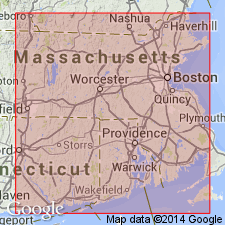
- Usage in publication:
-
- Short Point Member
- Modifications:
-
- Named
- Dominant lithology:
-
- Phyllite
- Siltstone
- AAPG geologic province:
-
- New England province
Summary:
Fort Burnside Formation on Conanicut Island, southeastern RI, is here assigned to the newly named Conanicut Group. Unit is subdivided into Short Point and Taylor Point Members. The Short Point is characterized by rhythmic units of salmon-colored to buff siltstone, black phyllite, and gray phyllite. Ripples and cross-laminations are abundant in siltstones; liquefaction structures common in basal phyllites. The Taylor Point consists of alternating gray and black phyllites, but lacks the abundant siltstone beds of the Short Point. Fort Burnside overlies the Jamestown Formation and underlies the Dutch Harbor Island Formation, both of Conanicut Group. Thickness of the Fort Burnside is approximately 30 m. Taylor Point Member is generally thin (9 m), while laterally interfingering Short Point ranges to 30 m. Age of the lower part of the Fort Burnside is constrained to Middle Cambrian by fossils (PARADOXIDE) found in the Taylor Point. Top of Short Point may be Late Cambrian or younger. [Intent to name not stated.]
Source: GNU records (USGS DDS-6; Reston GNULEX).
For more information, please contact Nancy Stamm, Geologic Names Committee Secretary.
Asterisk (*) indicates published by U.S. Geological Survey authors.
"No current usage" (†) implies that a name has been abandoned or has fallen into disuse. Former usage and, if known, replacement name given in parentheses ( ).
Slash (/) indicates name conflicts with nomenclatural guidelines (CSN, 1933; ACSN, 1961, 1970; NACSN, 1983, 2005, 2021). May be explained within brackets ([ ]).

